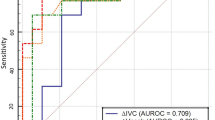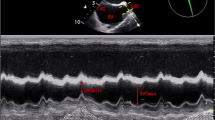Abstract
Objectives
To evaluate the sensitivity and specificity of inferior vena cava (IVC) distensibility index (∆IVC) and respiratory variation in peak aortic blood flow velocity (∆Vpeak) to predict fluid responsiveness in ventilated children with shock and to find out the best cut-off values for predicting fluid responsiveness.
Methods
In this prospective observational study, conducted in a pediatric ICU from January 2019 through May 2020, consecutive children aged 2 mo to 17 y with shock requiring fluid bolus were included. ∆IVC and ∆Vpeak were measured before and immediately after 10 ml/kg fluid bolus administration. ∆IVC and ∆Vpeak were compared between responders and non-responders, defined by a change in stroke volume index (SVI) of ≥10%.
Results
Thirty-seven ventilated children [26 (70.4%) boys] with median age of 60 (36, 108) mo were included. The median (IQR) ∆IVC was 21.7% (14.3, 30.9) and the median (IQR) ΔVpeak was 11.3% (7.2, 15.2). Twenty-three (62%) children were fluid responsive. The median (IQR) ∆IVC was higher in responders compared to non-responders [26% (16.9, 36.5) vs. 17.2% (8.4, 21.9); p = 0.018] and mean (SD) ΔVpeak was higher in responders [13.9% (6.1) vs. 8.4% (3.9), p = 0.004]. The prediction of fluid responsiveness with ΔIVC [ROC curve area 0.73 (0.56–0.9), p = 0.01] and ΔVpeak [ROC curve area 0.78 (0.63–0.94), p = 0.002] was similar. The best cut-off of ∆IVC to predict fluid responsiveness was 23% (sensitivity, 60.8%; specificity, 85.7%) and ΔVpeak was 11.3% (sensitivity, 74%; specificity, 86%).
Conclusions
In this study, authors found that ∆IVC and ΔVpeak were good predictors of fluid responsiveness in ventilated children with shock.


Similar content being viewed by others
References
Yager P, Noviski N. Shock. Pediatr Rev. 2010;31:311–9.
Davis AL, Carcillo JA, Aneja RK, et al. American College of Critical Care Medicine clinical practice parameters for hemodynamic support of pediatric and neonatal septic shock. Crit Care Med. 2017;45:1061–93.
Alobaidi R, Morgan C, Basu RK, et al. Association between fluid balance and outcomes in critically ill children: a systematic review and meta-analysis. JAMA Pediatr. 2018;172:257–68.
Raina R, Sethi SK, Wadhwani N, Vemuganti M, Krishnappa V, Bansal SB. Fluid overload in critically ill children. Front Pediatr. 2018;6:306.
Cherpanath TGV, Geerts BF, Lagrand WK, Schultz MJ, Groeneveld ABJ. Basic concepts of fluid responsiveness. Neth Heart J. 2013;21:530–6.
Gan H, Cannesson M, Chandler JR, Ansermino JM. Predicting fluid responsiveness in children: a systematic review. Anesth Analg. 2013;117:1380–92.
Kleinman ME, Chameides L, Schexnayder SM, et al. Part 14: pediatric advanced life support: 2010 American Heart Association Guidelines for Cardiopulmonary resuscitation and emergency cardiovascular care. Circulation. 2010;122:S876-908.
Thabet FC, Ejike JC. Intra-abdominal hypertension and abdominal compartment syndrome in pediatrics. a review. J Crit Care. 2017;41:275–82.
Achar SK, Sagar MS, Shetty R, et al. Respiratory variation in aortic flow peak velocity and inferior vena cava distensibility as indices of fluid responsiveness in anaesthetised and mechanically ventilated children. Indian J Anaesth. 2016;60:121–6.
Feissel M, Mangin I, Ruyer O, Faller JP, Michard F, Teboul JL. Respiratory changes in aortic blood velocity as an indicator of fluid responsiveness in ventilated patients with septic shock. Chest. 2001;119:867–73.
Marik PE, Cavallazzi R. Does the central venous pressure predict fluid responsiveness? an updated meta-analysis and a plea for some common sense. Crit Care Med. 2013;41:1774–81.
Desgranges FP, Desebbe O, Pereira de Souza Neto E, Raphael D, Chassard D. Respiratory variation in aortic blood flow peak velocity to predict fluid responsiveness in mechanically ventilated children: a systematic review and meta-analysis. Pediatr Anesth. 2016;26:37–47.
Wang X, Jiang L, Liu S, Ge Y, Gao J. Value of respiratory variation of aortic peak velocity in predicting children receiving mechanical ventilation: a systematic review and meta-analysis. Crit Care. 2019;23:372.
Kim DW, Chung S, Kang WS, Kim J. Diagnostic accuracy of ultrasonographic respiratory variation in the inferior vena cava, subclavian vein, internal jugular vein, and femoral vein diameter to predict fluid responsiveness: a systematic review and meta-analysis. Diagnostics (Basel). 2021;12:49.
Weber T, Wagner T, Neumann K, Deusch E. Low predictability of three different noninvasive methods to determine fluid responsiveness in critically ill children. Pediatr Crit Care Med. 2015;16:e89.
Si X, Cao D, Xu H, Guan X. Meta-analysis of ventilated versus spontaneously breathing patients in predicting fluid responsiveness by inferior vena cava variation. Int J Clin Med. 2018;9:760–77.
Xavier Filho DG, Coutinho ALN, Barbosa RH de A, Lopes MR, Tenório AP de O. Inferior vena cava ultrasound for assessing volume status and fluid responsiveness in critically ill patients: a systematic review. Arq Bras Cardiol Imagem Cardiovasc. 2021;34:eabc193.
Choi DY, Kwak HJ, Park HY, Kim YB, Choi CH, Lee JY. Respiratory variation in aortic blood flow velocity as a predictor of fluid responsiveness in children after repair of ventricular septal defect. Pediatr Cardiol. 2010;31:1166–70.
Byon HJ, Lim CW, Lee JH, et al. Prediction of fluid responsiveness in mechanically ventilated children undergoing neurosurgery. Br J Anaesth. 2013;110:586–91.
Acknowledgements
The authors are thankful to PICU senior residents and junior residents for their contribution to the conduct of the study.
Author information
Authors and Affiliations
Contributions
KKB, JS conceptualized the study, enrolled patients, analyzed the data and drafted the manuscript; DK conceptualized the study, verified all the echocardiographic data and helped with the manuscript; PG helped with patient enrollment, collected data and provided inputs to the manuscript; MP helped with statistical analysis and provided inputs to the manuscript; SKK and RL provided critical inputs to the manuscript and supervised the study. SKK will act as the guarantor for this manuscript.
Corresponding author
Ethics declarations
Conflict of Interest
None.
Additional information
Publisher's Note
Springer Nature remains neutral with regard to jurisdictional claims in published maps and institutional affiliations.
Supplementary Information
Below is the link to the electronic supplementary material.
Rights and permissions
Springer Nature or its licensor (e.g. a society or other partner) holds exclusive rights to this article under a publishing agreement with the author(s) or other rightsholder(s); author self-archiving of the accepted manuscript version of this article is solely governed by the terms of such publishing agreement and applicable law.
About this article
Cite this article
Banothu, K.K., Sankar, J., Pathak, M. et al. Utility of Inferior Vena Cava Distensibility and Respiratory Variation in Peak Aortic Blood Flow Velocity to Predict Fluid Responsiveness in Children with Shock. Indian J Pediatr 90, 1077–1082 (2023). https://doi.org/10.1007/s12098-023-04585-x
Received:
Accepted:
Published:
Issue Date:
DOI: https://doi.org/10.1007/s12098-023-04585-x




